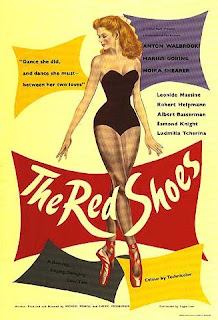The Red Shoes
 A few months ago, I was reading Martin Scorsese's MySpace page (I know, that sounds odd) and he wrote what his five favorite films of all time are (and stressed that they are in no particular order): Citizen Kane, The Searchers, 8 1/2, The Red Shoes, and The Leopard. I was a little taken aback, as I had never seen two of them. I'm now getting around to changing that.
A few months ago, I was reading Martin Scorsese's MySpace page (I know, that sounds odd) and he wrote what his five favorite films of all time are (and stressed that they are in no particular order): Citizen Kane, The Searchers, 8 1/2, The Red Shoes, and The Leopard. I was a little taken aback, as I had never seen two of them. I'm now getting around to changing that.First up, The Red Shoes (1948), which I guess I had avoided all these years for its reputation as a "women's" picture. Upon seeing it, I can say that it's not really a film onlyfor women, but if you happen to be a balletomane it would probably help. It's also easy to see what gets Scorsese excited about it, as it is a technical marvel, much like Citizen Kane. As a piece of emotional storytelling, though, I found it to creak with melodrama.
But it is sumptuous. The color, particularly, is stunning in its vividness. It's almost like a moving watercolor painting. The photography is by Jack Cardiff, and he had also done Black Narcissus (which was done by the same directors, Michael Powell and Emeric Pressburger). On the reputation of those two pictures alone Cardiff won a Lifetime Achievement Oscar a few years ago.
When I say the film creaks a bit, I don't mean to dismiss the story, though, as there are times when it unfolds with supreme grace. It begins with students rushing to grab balcony seats at a new ballet. At first you think these characters might be just extras, and it turns out that all but one are. Only one of these characters appears again, and he is one of the triad that the film rests on. Marius Goring plays a young composer who, as he listens to the music of the ballet, realizes that it is his music, plagiarized by his professor. He writes an angry letter to the director of the ballet company, Anton Walbrook, and when he tries to retrieve it, Walbrook hires him as a deputy conductor.
Attending a party, Walbrook meets a young British dancer, played by Moira Shearer, and admiring her spirit, adds her to the company. Eventually he sees her capability for greatness, and also falls in love with her, in his own way. He commissions Goring to write a ballet for her, based on the Hans Christian Anderson fairy tale, The Red Shoes. She becomes a star, but when she and Goring fall in love, Walbrook angrily tries to break them up and fails. He believes that love is a distraction and no one be both a great dancer and part of a relationship.
Walbrook is the focal character of the film. Said to be based on Diaghilev, the great Russian impresario, Walbrook is a charming monster, a man who likes to control those who work with him. He wants to forge Shearer in his own image, and possess her, not in a romantic sense. In fact, Walbrook's character would seem to be asexual, concerned only with creating the best ballets he can.
This issue of art versus the simple happiness of love is fairly compelling, and builds to a gripping climax, as Shearer is forced to choose between Walbrook and Goring. The spine of the fairy tale, which has a young girl wearing red shoes that don't allow her to stop dancing, is apparent as well. The extreme ending, though inevitable perhaps, is still a bit over the top.
The Red Shoes is the type of movie that other filmmakers can watch endlessly and point out touches of brilliance in technique, but for me I need to be involved on an emotional level, and it just didn't do it for me. I also have to admit that the centerpiece, the twenty-minute actual ballet of the Red Shoes, though beautiful, had my mind wandering a bit. I'm a hopeless philistine when it comes to ballet, I guess.


I assume The Leopard is the other one that you haven't seen?
ReplyDeleteYes, although now I have seen it, as of yesterday. A post will go up about it today.
ReplyDelete